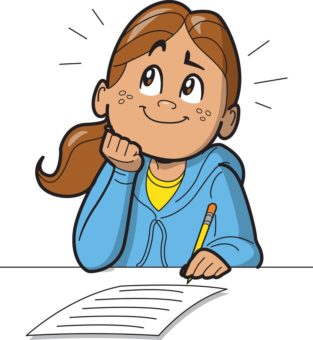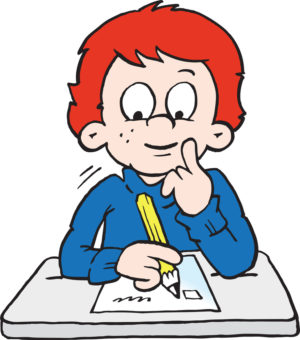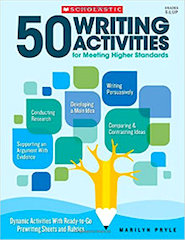Five-Step, Never-Fail Character Sketching
By Marilyn Pryle
 You’ve heard of the “Never-Fail Chicken” or the “Never-Fail Pie Crust,” right? Well this activity, the “Never-Fail Character Sketch,” NEVER. FAILS.
You’ve heard of the “Never-Fail Chicken” or the “Never-Fail Pie Crust,” right? Well this activity, the “Never-Fail Character Sketch,” NEVER. FAILS.
I’ve used it with all levels of ELA students and a wide range of ages. I’ve used it in ESL classes and creative writing classes. The result is always the same: strong, detailed, heartfelt writing.
Why is it so effective? Because the Character Sketch asks students to use their lives, or specifically, the people in their lives, as fertile ground. And everyone has someone that they know well, be it a parent, grandparent, sibling, or friend.
Usually, these pieces are the most moving ones I get all year. How often do we really look closely at the people we love? Students are surprised at how many small details they know about a person when they are given time and space to think about it.
The Character Sketch is built on sensory details and a basic notion of theme. And it is only a sketch, not a full story with a developed plot and climax. The focus is on description.
Of course, the elements of characterization (what a character looks like, does, and says) are highlighted in this assignment; after completing this activity, students will more readily recognize characterization techniques in their reading as well.
The key to this lesson is the main prewriting activity, a teacher-guided brainstorming session which yields a trove of details. In my experience, a live, whole-class, teacher-led brainstorming works best for this assignment. Of course, if this is not possible, simply copy or post the questions for the students. The questions are given below. Enjoy.
Questions for a Character Sketch Brainstorming Session
To be read aloud by teacher. Give students plenty of time to write.
Choose a person that you know well – a family member or close friend. No pets. Write the person’s name at the top of your paper.

Give students a few minutes here, and then continue…
–Is the person tall or short, or in the middle?
–Are they thin, medium, or stout? Muscular? Small?
–Is the person young or middle-aged, or old? How can you tell?
–What is the eye color? The hair color? What is the hair style?
–Look closely at the person’s face. What do you see?
–Is there anything interesting about the eyes, the eyebrows? Does the person have a moustache or beard?
–What is the smile like? Big? Shy? Crooked?
–What does the person usually wear? If pants, what kind? What style shirt? Describe the shoes.
–Look at the person’s hands. Is there anything notable about them?
–Is he or she dark-skinned, light-skinned, olive, pale, freckled, or something else? How would you describe their skin?
–Does the person usually wear a certain piece of jewelry, like a necklace, bracelet, or ring? Describe it.
–Does the person usually carry something, like a wallet or purse, or a phone, or some kind of good luck charm or religious item?
–What are some of the person’s favorite belongings?
–How does the person smell? Does he or she commonly smell like coffee, for example, or a certain perfume? (I realize I’m sneaking this one in under “Looks,” but a person’s smell contributes, I think, to the overall physical impact.)
2. Leave some space under this list in case anything else comes to mind. If it does, just jot it down, even if you’re in the middle of another section. Find a new space, either to the side or on the back of the paper, and write down “Actions.” This will be a section for what the person does. I want you to use verb phrases here.
–Think of the person again. Is there something, some habit, that they are always doing? For example, do they tap a foot or fingers? Do they twirl their hair? Flip open their phone? Yawn all the time because they never get enough sleep? Overstuff their purse so they can’t find anything? Always misplace their glasses? Do they often clear their throat when talking? (You may want to write some of these phrases on the board, verb first, to illustrate the structure.)
–[For more advanced students] What does the person do that makes them who they are today? Does the person have any rituals or routines that happen regularly, over time? How about the person’s career? Try to think of these in the present perfect or present perfect progressive tense. For example, have they flown planes for 20 years or cooked dinner every day for ten years? You would say, they have flown planes or have cooked dinner… Another example: They have been reading the news every morning since they turned 15.
–Think of how the person walks. Try to think of another verb besides “walk” to describe what it looks like. Does the person shuffle or drag their feet? Stumble or trip often? Swagger or saunter? Tiptoe or skip? Stomp? Does anyone want to demonstrate a walk so we can find a verb for it?
–Think of the person’s laugh. Try to describe it with a precise verb. Does the person giggle, hiccup or chirp? Guffaw? Snort? Choke? Any demonstrations?
–Think of how the person speaks. Try to find a word to describe it. Do they squeak or growl? Does the person often whisper or yell?

–Does the person have a certain greeting, like “What’s up dude?”
–Does the person have a nickname for you?
–Does the person always want to do something? For example, you know that when you see the person, they will most likely say, “Let’s go to Jackie’s house!” or “Let’s watch the game!” or “Want to play Overwatch?” or “Did you study for the test?”
–Does the person often complain about something? For example, do they often say, “I wish we didn’t have homework!” or “I hate the winter!”
4. Now, go to another space on your paper and think about why this person is important to you. What have you learned from this person? Write a few sentences that come to mind.
5. Finally, think of a place that you can imagine your person in. What do they like to do? Where do you usually see them? What are they doing? It doesn’t have to be something unusual or special; it should be an everyday place where you commonly see the person.
–Once you have a scene in your mind, think about your five senses.
–What are the sights in this scene? What objects are around? What colors?
–What is the light like? If it is outside, is it sunny, cloudy, dim, or nighttime?
–What are the sounds?
–What are some smells?
–What are some physical feelings? Is it cold or hot? What are some textures?
Remember, this is not a story; it is only a description. Nothing big should happen in this scene. The person is just doing some small thing they always do.
Creating a scene to surround the character
At this point, most students will have a couple pages of details. I tell them to appreciate how much they know! Their next step is to start with the scene (#5) and to simply imagine their person in it. Then write out the moment, packing in as many details as possible. It might be helpful to show them an example (one is included at the end of this article).

I stress to students that this is not a story, only a sketch. And I tell them that it doesn’t have to be exactly something that happened in real life; it can be a composite of normal, real-life moments that could happen on any given day. It’s how the person is, rather than a reporting of a time that happened. When all description is finished, the students should end with a theme—why the person is important to them (#4 in the brainstorming).
I absolutely love reading what the students write for this activity. Not only is the writing good, but I get a real, textured glimpse into the students’ lives. These pieces can easily grow into larger stories; lead students through the idea of character motivation and voila, a plot has begun. But more often than not, I like to leave these sketches just as they are: genuine, detailed, beautiful, human moments.
Model Writing: A Student’s Character Sketch
Sweet Like Cherries (by Sarah L.)
I gasped for air as Alyssa shoved a bright red spray bottle in my face. “Just try it!!!” she blabbered. I explained to her that I didn’t want her Chloraseptic numbing throat spray. She has always been obsessed with that spray because she’s a singer and needs to keep her throat in tip-top shape. I didn’t even yell at Alyssa for being loud in public because I’m immune to her obnoxiousness.

Alyssa is the one who riles me up. Her sarcastic sense of humor brings out the outgoing side of my personality. Alyssa sat back in her chair, making me realize she is wearing the powder white boho lace top she always wears. Her current blonde hair (her hair color is always changing) was softly curled. Her wide, powder blue eyes were sparkling. She smiled warmly at me, the freckles on her cheeks ruffled.
She quickly spritzed the red spray into her mouth and leaned over the table to put it away in her purse. Her purse has a portrait of Elvis Presley, one of her favorite musicians, printed on it. She uses it everyday. It was filled with stray change, her school ID badge lanyard (with no actual ID card attached – she lost that a long time ago), and her insulin needles. As dramatic as Alyssa is, she never complains about her diabetes. She actually barely mentions it. It’s the one thing that she is quiet about.
Alyssa has brought so many new aspects into my life. She has taught me how to relax and how to not stress over little issues. She also is the reason I have a sarcastic sense of humor. Without her I would not be the open and outgoing person I am.
Marilyn Pryle is a National Board Certified secondary public school teacher (English/Language Arts) with experience in middle and high school. She holds an Ed.D. in Curriculum & Instruction and was the 2021 Pennsylvania Teacher of the Year and a Fulbright Scholar in 2021.
Marilyn is the author of many books about teaching, including Reading with Presence: Crafting Mindful, Evidence-Based Reading Responses (Heinemann, 2018) and 50 Writing Activities for Meeting Higher Standards (Scholastic, 2017). Her new Heinemann book is Critical Reading in the Age of Disinformation: 5 Questions for Any Text. Learn more about her work at her website and read her many articles for MiddleWeb here.
This article was adapted from the book 50 Writing Activities for Meeting Higher Standards (Scholastic, 2017).



































